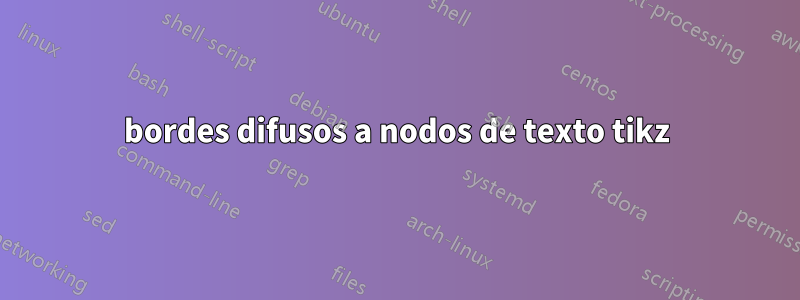
Estoy intentando dibujar la siguiente imagen con tikz:

Lo que sucede exactamente es que parece que el cuadro de texto es como una capa encima de la matriz de objetos. Quiero que parezcan como si estuvieran en la misma capa. Y creo que puedo lograrlo si puedo atenuar el borde alrededor del cuadro de texto y hacerlo borroso (desaparecer gradualmente).
Intenté utilizar las soluciones deesta pregunta, pero no funciona.
¿Es posible hacer esto?
El código es el siguiente:
\documentclass{article}
\usepackage{tikz}
\usetikzlibrary{arrows,automata,calc,shapes, positioning,shadows,shadows.blur,shapes.geometric}
\begin{document}
\scalebox{0.5}{
\begin{tikzpicture}
\tikzset{fontscale/.style = {font=\relsize{#1}}}
\newcommand{\mymacro}{
% Axis
\draw (-0.1,0) -- (1.0,0);
\draw (0,-0.1) -- (0,0.5);
\draw[fill=gray!50] (0.1,0.35) rectangle ++(0.2,0.2);
\draw[fill=gray!50] (0.2,0.07) rectangle ++(0.4,0.2);
% \node (rect) at (0.3,0.4) [draw,minimum height=0.05cm,minimum width=0.2cm,fill=gray!50] {};
% \node (rect) at (0.5,0.2) [draw,minimum height=0.05cm,minimum width=0.3cm,fill=gray!50] {};
};
\begin{scope}
\foreach \x in {1,...,9}
{
\foreach \y in {1,...,9}
{
\begin{scope}[xshift=10\x cm,yshift=10\y cm]
\mymacro
\end{scope}
}
}
\end{scope}
\begin{scope}[xshift=9cm]
\foreach \x in {1,...,9}
{
\foreach \y in {1,...,9}
{
\begin{scope}[xshift=10\x cm,yshift=10\y cm]
\mymacro
\end{scope}
}
}
\end{scope}
\begin{scope}[xshift=18cm]
\foreach \x in {1,...,9}
{
\foreach \y in {1,...,9}
{
\begin{scope}[xshift=10\x cm,yshift=10\y cm]
\mymacro
\end{scope}
}
}
\end{scope}
\begin{scope}[xshift=18cm,yshift=9cm]
\foreach \x in {1,...,9}
{
\foreach \y in {1,...,9}
{
\begin{scope}[xshift=10\x cm,yshift=10\y cm]
\mymacro
\end{scope}
}
}
\end{scope}
\begin{scope}[yshift=9cm]
\foreach \x in {1,...,9}
{
\foreach \y in {1,...,9}
{
\begin{scope}[xshift=10\x cm,yshift=10\y cm]
\mymacro
\end{scope}
}
}
\end{scope}
\begin{scope}[xshift=9cm,yshift=9cm]
\foreach \x in {1,...,9}
{
\foreach \y in {1,...,9}
{
\begin{scope}[xshift=10\x cm,yshift=10\y cm]
\mymacro
\end{scope}
}
}
\end{scope}
\begin{scope}[xshift=115cm,yshift=110cm]
\node[draw,fill=white,scale=3,rounded corners] (temppicnode) {2 proc., 10 tasks$\approx$ 1000+ solutions};
\clip (temppicnode.south west) rectangle (temppicnode.north east);
\pgfmathsetmacro{\mybmax}{sqrt(2)*0.3}
\pgfmathsetmacro{\mystep}{0.3/(20+1)}
\pgfmathsetmacro{\myradstep}{sqrt(2)*0.3/(20+1)}
\foreach \x [evaluate=\x as \mypred using \x-1] in {1,...,20}
{ \pgfmathsetmacro{\myrad}{\mybmax-(\x-1)*\myradstep}
\fill[white,even odd rule,opacity=0.1] ($(temppicnode.south west)+(-0.3,-0.3)$) rectangle ($(temppicnode.north east)+(0.3,0.3)$) [rounded corners=\myrad cm] ($(temppicnode.south west)+(\x*\mystep,\x*\mystep)$) rectangle ($(temppicnode.north east)+(-\x*\mystep,-\x*\mystep)$);
}
%\draw (temppicnode.north east) rectangle (temppicnode.south west);
\fill[white,even odd rule] ($(temppicnode.south west)+(-0.3,-0.3)$) rectangle ($(temppicnode.north east)+(0.3,0.3)$) [rounded corners=0.3 cm] (temppicnode.south west) rectangle (temppicnode.north east);
\end{scope}
%\node[draw=none,fill=white,scale=3,text=white,rounded corners] at (115,110) {2 proc., 10 tasks$\approx$ 1000+ solutions};
%\node[draw=none,fill=white,scale=3] at (115,110) {2 proc., 10 tasks$\approx$ 1000+ solutions};
\end{tikzpicture}}
\end{document}


